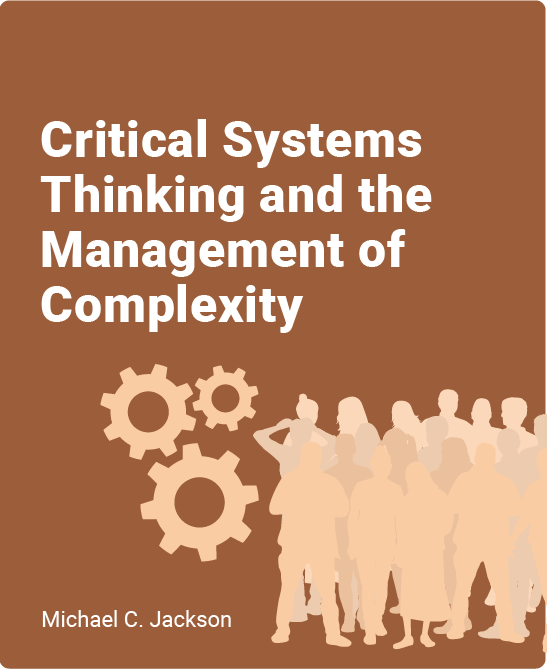Table of Contents
Philosophy
1.1 Introduction
1.2 Kant
1.3 Hegel
1.4 Pragmatism
1.5 Husserl and Phenomenology
1.6 Radical Constructivism
1.7 Conclusion
2 The Physical Sciences and the Scientific Method
2.1 Introduction
2.2 The Scientific Method and the Scientific Revolution
2.3 The Physical Sciences in the Modern Era
2.4 The Scientific Method in the Modern Era
2.5 Extending the Scientific Method to Other Disciplines
2.6 Conclusion
3 The Life Sciences
3.1 Introduction
3.2 Biology
3.3 Ecology
3.4 Conclusion
4 The Social Sciences
4.1 Introduction
4.2 Functionalism
4.3 Interpretive Social Theory
4.4 The Sociology of Radical Change
4.5 Postmodernism and Poststructuralism
4.6 Integrationist Social Theory
4.7 Luhmann’s Social Systems Theory
4.8 Action Research
4.9 Conclusion
Part II The Systems Sciences
5 General Systems Theory
5.1 Introduction
5.2 von Bertalanffy and General System Theory
5.3 von Bertalanffy’s Collaborators and the Society for General Systems Research
5.4 Miller and the Search for Isomorphisms at Different System Levels
5.5 Boulding, Emergence and the Centrality of “The Image”
5.6 The Influence of General Systems Theory
5.7 Conclusion
6 Cybernetics
6.1 Introduction
6.2 First Order Cybernetics
6.3 British Cybernetics
6.4 Second Order Cybernetics
6.5 Conclusion
7 Complexity Theory
7.1 Introduction
7.2 Chaos Theory
7.3 Dissipative Structures
7.4 Complex Adaptive Systems
7.5 Complexity Theory and Management
7.6 Complexity Theory and Systems Thinking
7.7 Conclusion
Part III Systems Practice
8 A System of Systems Methodologies
8.1 Introduction 151
8.2 Critical or “Second Order” Systems Thinking
8.3 Toward a System of Systems Methodologies
8.3.1 Preliminary Considerations
8.3.2 Beer’s Classification of Systems
8.3.3 The Original “System of Systems Methodologies”
8.3.4 Snowden’s Cynefin Framework
8.3.5 A Revised “System of Systems Methodologies”
8.4 The Development of Applied Systems Thinking
8.5 Systems Thinking and the Management of Complexity
8.6 Conclusion
Type A Systems Approaches for Technical Complexity
9 Operational Research, Systems Analysis, Systems Engineering (Hard Systems Thinking)
9.1 Prologue
9.2 Description of Hard Systems Thinking
9.2.1 Historical Development
9.2.2 Philosophy and Theory
9.2.3 Methodology
9.2.4 Methods
9.2.5 Developments in Hard Systems Thinking
9.3 Hard Systems Thinking in Action
9.4 Critique of Hard Systems Thinking
9.5 Comments
9.6 The Value of Hard Systems Thinking to Managers
9.7 Conclusion
Type B Systems Approaches for Process Complexity
10 The Vanguard Method
10.1 Prologue
10.2 Description of the Vanguard Method
10.2.1 Historical Development
10.2.2 Philosophy and Theory
10.2.3 Methodology
10.2.4 Methods
10.3 The Vanguard Method in Action
10.3.1 Check
10.3.2 Plan
10.3.3 Do
10.4 Critique of the Vanguard Method
10.5 Comments
10.6 The Value of the Vanguard Method to Managers
10.7 Conclusion
Type C Systems Approaches for Structural Complexity
11 System Dynamics
11.1 Prologue
11.2 Description of System Dynamics
11.2.1 Historical Development
11.2.2 Philosophy and Theory
11.2.3 Methodology
11.2.4 Methods
11.3 System Dynamics in Action
11.4 Critique of System Dynamics
11.5 Comments
11.6 The Value of System Dynamics to Managers
11.7 Conclusion
Type D Systems Approaches for Organizational Complexity
12 Socio‐Technical Systems Thinking
12.1 Prologue
12.2 Description of Socio Technical Systems Thinking
12.2.1 Historical Development
12.2.2 Philosophy and Theory
12.2.3 Methodology
12.2.4 Methods
12.3 Socio Technical Systems Thinking in Action
12.4 Critique of Socio Technical Systems Thinking
12.5 Comments
12.6 The Value of Socio Technical Systems Thinking to Managers
12.7 Conclusion
13 Organizational Cybernetics and the Viable System Model
13.1 Prologue
13.2 Description of Organizational Cybernetics
13.2.1 Historical Development
13.2.2 Philosophy and Theory
13.2.3 Methodology
13.2.4 Methods
13.3 Organizational Cybernetics in Action
13.4 Critique of Organizational Cybernetics and the Viable System Model
13.5 Comments
13.6 The Value of Organizational Cybernetics to Managers
13.7 Conclusion
Type E Systems Approaches for People Complexity
14 Strategic Assumption Surfacing and Testing
14.1 Prologue
14.2 Description of Strategic Assumption Surfacing and Testing
14.2.1 Historical Development
14.2.2 Philosophy and Theory
14.2.3 Methodology
14.2.4 Methods
14.3 Strategic Assumption Surfacing and Testing in Action
14.4 Critique of Strategic Assumption Surfacing and Testing
14.5 Comments
14.6 The Value of Strategic Assumption Surfacing and Testing to Managers
14.7 Conclusion
15 Interactive Planning
15.1 Prologue
15.2 Description of Interactive Planning
15.2.1 Historical Development
15.2.2 Philosophy and Theory
15.2.3 Methodology
15.2.4 Methods
15.3 Interactive Planning in Action
15.4 Critique of Interactive Planning
15.5 Comments
15.6 The Value of Interactive Planning to Managers
15.7 Conclusion
16 Soft Systems Methodology
16.1 Prologue
16.2 Description of Soft Systems Methodology
16.2.1 Historical Development
16.2.2 Philosophy and Theory
16.2.3 Methodology
16.2.4 Methods
16.3 Soft Systems Methodology in Action
16.4 Critique of Soft Systems Methodology
16.5 Comments
16.6 The Value of Soft Systems Methodology to Managers 442
16.7 Conclusion 443
Type F Systems Approaches for Coercive Complexity
17 Team Syntegrity
17.1 Prologue
17.2 Description of Team Syntegrity
17.2.1 Historical Development
17.2.2 Philosophy and Theory
17.2.3 Methodology
17.2.4 Methods
17.3 Team Syntegrity in Action
17.4 Critique of Team Syntegrity
17.5 Comments
17.6 The Value of Team Syntegrity to Managers
17.7 Conclusion
18 Critical Systems Heuristics
18.1 Prologue
18.2 Description of Critical Systems Heuristics
18.2.1 Historical Development
18.2.2 Philosophy and Theory
18.2.3 Methodology
18.2.4 Methods
18.3 Critical Systems Heuristics in Action
18.4 Critique of Critical Systems Heuristics
18.5 Comments
18.6 The Value of Critical Systems Heuristics to Managers
18.7 Conclusion
Part IV Critical Systems Thinking
19 Critical Systems Theory
19.1 Introduction
19.2 The Origins of Critical Systems Theory
19.2.1 Critical Awareness
19.2.2 Pluralism
19.2.3 Emancipation or Improvement
19.3 Critical Systems Theory and the Management Sciences
19.4 Conclusion
20 Critical Systems Thinking and Multimethodology
20.1 Introduction
20.2 Total Systems Intervention
20.2.1 Background
20.2.2 Multimethodology
20.2.3 Case Study
20.2.4 Critique
20.3 Systemic Intervention
20.3.1 Background
20.3.2 Multimethodology
20.3.3 Case Study
20.3.4 Critique
20.4 Critical Realism and Multimethodology
20.4.1 Background
20.4.2 Multimethodology
20.4.3 Case Study
20.4.4 Critique
20.5 Conclusion
21 Critical Systems Practice
21.1 Prologue
21.2 Description of Critical Systems Practice
21.2.1 Historical Development
21.2.2 Philosophy and Theory
21.2.3 Multimethodology
21.2.4 Methodologies
21.2.5 Methods
21.3 Critical Systems Practice in Action
21.3.1 North Yorkshire Police
21.3.2 Kingston Gas Turbines
21.3.3 Hull University Business School
21.4 Critique of Critical Systems Practice
21.5 Comments
21.6 The Value of Critical Systems Practice to Managers
21.7 Conclusion
zyText are leading print textbooks available in full on the zyBooks platform. Each zyText has been adapted to include learning questions and answer-specific feedback allowing for a quick and easy transition to an engaging digital experience for instructors and students.
What You’ll Find In This zyText:
- Incorporates the complete text
- Over 150 learning questions with answer-specific feedback
- Customization tools letting you add, remove or reorder chapters and sections
- Options to align the book directly to your syllabus – including videos, images, text
- Analytics that help you measure student engagement
- Ability to hold students accountable for reading before class
- A competitive low price point
- Students can keep a PDF version of key chapters at no additional cost
From the winner of the INCOSE Pioneer Award 2022
- Leaders of international bodies such as the UN, OECD, UNESCO and WHO have all declared
that systems thinking is an essential leadership skill for managing the complexity of the
economic, social and environmental issues that confront decision makers. Systems thinking
must be implemented more generally, and on a wider scale, to address these issues. - Over 25 case studies focused on the development of systems thinking and of major efforts
to apply the approach in real-world interventions. - Encourages the widespread use of critical systems practice as a means of ensuring
responsible leadership in a complex world.
Author
Michael C. Jackson

